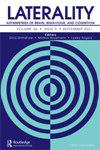下一个十年的偏侧性:神经元不对称的成本和收益——将偏侧化置于进化的背景下。
IF 0.9
4区 心理学
Q4 PSYCHOLOGY, EXPERIMENTAL
引用次数: 9
摘要
在我对Ocklenburg等人的目标文章的评论中。[横向2020:进入下一个十年。一侧,1-33。[doi:10.1080/1357650X.2020.1804396],我指出了在自然环境中对非人类物种进行研究的相关性,以了解影响大脑不对称方向和程度的生态压力。因此,我概述了一些主要的研究项目,这些项目没有包括在Ocklenburg等人的论文中,并且需要进行比较动物研究。本文章由计算机程序翻译,如有差异,请以英文原文为准。
Laterality for the next decade: Costs and benefits of neuronal asymmetries - putting lateralization in an evolutionary context.
In my comment on the target article of Ocklenburg et al. [Laterality 2020: Entering the next decade. Laterality, 1-33. doi:10.1080/1357650X.2020.1804396], I point out the relevance of studies in non-human species within natural settings for understanding the ecological pressures, which shape the direction and degree of brain asymmetries. I therefore outline some major research projects, which are not included in the paper of Ocklenburg et al. and which require comparative animal research.
求助全文
通过发布文献求助,成功后即可免费获取论文全文。
去求助
来源期刊

Laterality
Multiple-
CiteScore
3.60
自引率
7.10%
发文量
26
期刊介绍:
Laterality: Asymmetries of Body, Brain and Cognition publishes high quality research on all aspects of lateralisation in humans and non-human species. Laterality"s principal interest is in the psychological, behavioural and neurological correlates of lateralisation. The editors will also consider accessible papers from any discipline which can illuminate the general problems of the evolution of biological and neural asymmetry, papers on the cultural, linguistic, artistic and social consequences of lateral asymmetry, and papers on its historical origins and development. The interests of workers in laterality are typically broad.
 求助内容:
求助内容: 应助结果提醒方式:
应助结果提醒方式:


